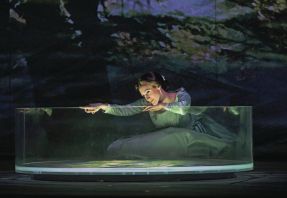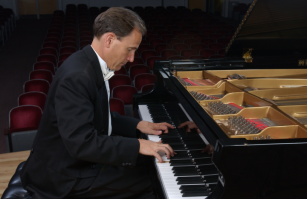Productions of Lucia, Alcina and Golden Cockerel offer musical treasures
By Peter Alexander
The Santa Fe Opera 2017 season, which continues through Aug. 26, offers three productions of remarkable musical accomplishment.
The stagings, however, are less consistently successful, ranging from one that is brilliant in conception and execution to another that is bafflingly undramatic. The operas are Donizetti’s Lucia di Lammermoor, Handel’s Alcina, and Rimsky-Korsakov’s infrequently performed masterpiece, The Golden Cockerel, all of which I saw the week of July 31.
The world premiere production of The (R)evolution of Steve Jobs by Mason Bates, performed Aug. 4, will be reviewed separately.

Soprano Brenda Rae as Lucia. Photo by Ken Howard for the Santa Fe Opera.
Brenda Rae, singing the title role of Lucia di Lammermoor Aug. 31, gave a virtual master class in bel canto singing. She sang with uncommon control and purity of sound, achieving an unimpeachable evenness of line across all registers and levels of volume. Every note was part of a phrase. The coloratura was thrilling, even at pianissimo.
Agility, lyricism, range, expression—the whole package was present. Her portrayal of Lucia’s descent into madness was particularly effective, making the famous mad scene not a stand-alone show-piece, but as it should be the culmination of Lucia’s dramatic arc.

Brenda Rae and Mario Chang. Photo by Ken Howard.
Rae was well supported by the rest of a remarkably strong cast. Mario Chang was vocally superb as Edgardo, matching Lucia with a strong, resonant tenor. His arias were deeply expressive and he paired well with Lucia in their duets.
As Lucia’s brother, Enrico Ashton, Zachary Nelson had a strong, weighty and when, necessary, malevolent baritone. The intensity of his increasing demands for Lucia to sacrifice herself for his honor ratcheted the dramatic tension effectively. With voice and presence, he was as villainous as the story requires.
As the chaplain Raimondo, Christian Van Horn’s powerful bass commanded the stage when he announced the discovery of the bridegroom’s lifeless body and Lucia’s madness. His character is ambivalent, first defending Lucia, then advising her to accept her destiny, and he was equally resolute in these changing declarations.
Stephen Martin was effective as the scheming Normanno, as was Carlos Santelli in the small and thankless role of Lucia’s doomed bridegroom. Sarah Coit was everything that is needed for the standard role of the soprano’s confidante.
Corrado Rovaris and the outstanding Santa Fe Opera orchestra provided strong support for the cast. One member of the orchestra deserves extra mention: Friedrich Heinrich Kern played the glass harmonica, a welcome and spooky return to the original orchestration of the mad scene, instead of the more usual flute. Kern, who works and teaches composition in New York, was hired for the summer specifically to play the glass harmonica part in Lucia—an example of the SFO’s uncompromising commitment.
I have less to say about the production, which was minimal to the point of emptiness. Designer Riccardo Hernandez created a high-walled reflective box that is supposed to represent the increasingly cramped realm in which Lucia is caught as her fate closes in on her. The barest minimum of furniture is employed, while lighting projections by Peter Nigrini represented changing locales, from forest to hall.

Opera in a box: Scene 1 of Santa Fe’s Lucia. Photo by Ken Howard.
This might have impact if everything else was meaningful, but alas it was not. Stage director Ron Daniels often seemed to leave the singers to fend for themselves on an empty stage, with varying degrees of effectiveness. Due to space limitations in the box, the chorus often could do little more than stand in a row and sing.

Lucia at the “fountain.” Photo by Ken Howard.
Among other infelicities, when a fountain is called for in the second act, what appeared to be a large plastic Petrie dish with a few inches of water rose noisily from below stage. The stairs that Lucia must descend for her mad scene appeared and disappeared for no evident reason. In the final scene, the chorus that reveals Lucia’s death to Edgardo was arrayed in a single curving row far above the stage, looking like judges assembled to condemn the solitary miscreant below. Doors opened and closed noisily, to the detriment of music and drama. Contradicting the force of the musical performance, none of this added up to drama.
But bel canto opera is first of all about the music, and in that regard this was a Lucia to remember.
# # # # #
The production of Handel’s Alcina (which I saw Aug. 2) is highly entertaining, sometimes distracting, clever, campy, over the top and musically superb. Director David Alden, known for his politically charged, updated interpretations, has placed Alcina in the 1950s.
Clearly the era was a great source of inspiration. In Handel’s original, Ruggiero is the latest sexual slave held captive on a magical island by the sorceress Alcina, whose previous lovers have been changed to wild beasts and stones. In Adlen’s Alcina, Ruggiero has snuck into an abandoned movie theater in order to imagine Alcina as an ideal woman and seductress.

Elza van den Heever, Jacquelyn Stucker and Anna Christy in Santa Fe’s campy, entertaining Alcina. Photo by Ken Howard.
Without that information, found in the program book, I’m not sure what the audience would make of the production—people in movie-usher uniforms who change into gorilla suits, a brownie flash camera, vaudeville acrobats with animal masks who tumble on and off stage, and at the end, a smaller-than-life model of a perfect little suburban neighborhood symbolizing Ruggiero’s return to sanity.
The clarity of the foundational symbolism aside, the performance was marked by great energy and commitment from all performers. Alden asks a lot of the singers—to sing with a cigarette between clenched teeth, while hopping about the stage, while being lifted and carried by the acrobats, while being wheeled about the stage on a dissecting cart—which the cast undertook with cheerful enthusiasm.
In his day Handel wrote for entertainment, and so it is a form of authenticity to make Handel’s operas entertaining for modern audiences. For this purpose Alden has many wonderful ideas—sometimes too many ideas. At times the constant activity upstages the singers and subverts the Baroque ideal of placing attention on vocal prowess.

Daniela Mack as Bradamante in the safe, sane world of ’50s suburbia, at the end of Alcina. Photo by Ken Howard.
Nonetheless, there were moments of great beauty and emotional impact, and it is telling that the greatest of these came when there was only a single singer onstage with no hijinks to upstage the music. And it certainly does not hurt that just about the entire cast sang beautifully, handling the Baroque style with aplomb.
It seems unfair to single out any individual from the strong cast. As the enchanted Ruggiero, Paula Murrihy sang with a clean, clear voice that was meltingly beautiful in her arias. Daniela Mack did a fierce and brilliant rage aria as Bradamante/Ricciardo. As her tutor Melisso, Christian Van Horn sang with a full rich bass and commanding expression.

Anna Christy romps as Morgana in Alcina. Photo by Ken Howard.
Anna Christy, known to Colorado audiences for her Lucia with Opera Colorado and Baby Doe with Central City Opera, was a bright, saucy and fully engaging Morgana, a role with great comic potential that she grasped with glee. Alek Schrader was her equal as Oronte, conveying in action and voice his changing moods alternately in love with and furious with Morgana.
In the title role, Elza van den Heever was a convincing enchantress, pink glove and all. She sang with careful control, a beautiful pianissimo and long, expressive lines, in spite of occasional discomfort with the Handelian ornamentation.
Harry Bicket, Santa Fe Opera’s chief conductor, led a stylish modern-instrument performance. Gideon Davey’s scene and costume design and Beate Vollack’s choreography supported Alden’s interpretation effectively.
Some purists will be uncomfortable with the transformation of Alcina into a semi-modern parable, and the frenetic activity behind some of the scenes. A few sexual suggestions are in questionable taste. But I found it almost entirely a delightful entertainment, first-rate musically and wonderfully provocative.
# # # # #
If you have only one opera to see in Santa Fe, do not miss Rimsky-Korsakov’s gorgeous fairy-tale opera The Golden Cockerel. Scarcely known in the U.S., the opera was more than redeemed by the SFO’s brilliant production. Director Paul Curran took full advantage of the satirical aspects of the plot, creating a production that is magical, laugh-out-loud funny, and touching.
This is one of Rimsky’s most brilliant scores, full of bright colors and lush orchestration. In spite of the satirical elements, there are moments of serene beauty, as when the buffoonish Tsar Dodon is sleeping. Conductor Emmanuel Villaume led an unrushed, luxurious performance by the excellent SFO orchestra and cast. I cannot imagine a better realized, musically beautiful, or satisfying performance than I heard (Aug. 3).

Golden Cockerel. Photo by Ken Howard.
Equally noteworthy are the ingenious scene design and colorful costumes of Gary McCann. The costumes are spectacularly beautiful recreations of authentic Russian clothing of the early 20th century. The set—a stark reflective metal spiral—was enhanced with inventive projections by Driscoll Otto and the lighting design of Paul Hackenmueller.
The opera is a double satire of the vanity and foolishness of dynastic rulers. It was first a satire of Tsar Nicholas I, known for his endless wars against Russia’s neighbors, in the form of a poem by Pushkin written in 1834. Rimsky took Pushkin’s story and made it into a satire of Nicholas II and the disastrous Russo-Japanese War 71 years later. Unsurprisingly, the Tsarist censors of 1905 forbade performances of The Golden Cockerel. Rimsky refused to make changes, and died 3 years later without ever seeing it performed.

General Polkan (Kevin Burdette) leads Tsar Dodon (Tim Mix) gloriously to battle in The Golden Cockerel. Photo by Ken Howard.
The cast again is superb. Tim Mix did a great comic turn as the bumbling Tsar Dodon. Not only did he sing strongly, he conveyed Dodon’s pompous self-regard with every step and gesture. His wide-eyed infatuation with the Queen of Shemakha in the second act was comedy gold—and who could forget his mock-heroic exit to battle, backwards on a large hobby horse?

The Queen of Shemakha (Venera Gimadieva) leads the wide-eyed Tsar Dodon (Tim Mix) by the beard. Photo by Ken Howard.
The second act belongs to the Queen of Shemakha, 45 minutes of glittering coloratura and high-soprano showmanship. Venera Gimadieva sang with mastery of her part. In her best moments her capricious taunting of Dodon was fearsome, although she occasionally seemed too casual in her demeanor for the flirty, haughty queen.
The other roles large and small were more than capably covered. Barry Banks brought a penetrating tenor voice to the difficult role of the Astrologer who sets the story in motion, singing with impressive control of the daunting heights demanded by the role. Meredith Arwady was a deserving audience favorite as Dodon’s ebullient housekeeper Amelfa. Kasia Borowiec sang brightly in the small, repetitive but critical role of the Cockerel. And certainly not least, Kevin Burdette was wonderful, vocally and dramatically, as General Polkan, Dodon’s unfortunate general whose severed head is handed around at the opera’s climax.

Meredith Arwady as Amelfa in The Golden Cockerel. Photo by Ken Howard,
Like everything else in the opera, the severed head is only an illusion. In the brief epilogue, the astrologer comes back to life—after being summarily dispatched by Dodon—to assure the audience that only he and the queen are real. Everything else has been conjured—and magically realized on the Santa Fe Opera stage.
# # # # #
All three operas reviewed here have performances left, ending with Lucia di Lammermoor on Aug. 26. For dates of performances, visit the Santa Fe Opera 2017 calendar. Ticket information and pries can be seen here.





















